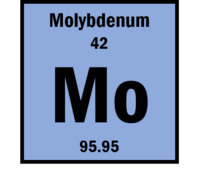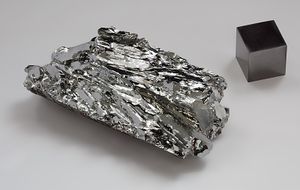Molybdenum

Molybdenum is the 42nd element on the periodic table of elements, and has the sixth highest melting melting point of all the elements.[2] Some of its properties are listed below:[2]
| Atomic weight | 95.95 |
| Density (at 0oC) | 10.2 g/cm3 |
| Boiling point | 4912 K |
| Melting point | 2895 K |
Molybdenum is a shiny, silvery, transition metal. It can primarily be found in molybdenite ore. Molybdenum is an important element in over fifty different enzymes used by plants and animals.[2]
Molybdenum Uses

Molybdenum is mostly used to make alloys, especially for items that are subjected to high heat (e.g. boilers). It is often used to make steel alloys for engine parts, heating elements, drills, and saw blades. Molybdenum-steel alloys have increased strength, hardness, ppelectrical conductivity]], and corrosion-resistance over regular steel. Molybdenum is used in several superalloys (alloys that excel at multiple desirable characteristics, such as high strength, corrosion resistance, etc.).[2]
Molybdenum compounds are used as a lubricant additives, petroleum catalysts, circuit board inks, pigments, and electrodes.[2]
Isotopes
Molybdenum has seven isotopes found in nature:[2]
| Symbol | Natural Abundance |
|---|---|
| 92Mo | 14.53% |
| 94Mo | 9.15% |
| 95Mo | 15.8% |
| 96Mo | 16.67% |
| 97Mo | 9.60% |
| 98Mo | 24.39% |
| 100Mo | 9.82% |
Video
The video below is from the University of Nottingham's periodic videos project.[4] They have created a complete suite of short videos on every element on the periodic table of elements.
For Further Reading
- Periodic table of elements
- Metal
- Alloy
- Catalyst
- Or explore a random page
References
- ↑ Made internally by a member of the Energy Education team.
- ↑ 2.0 2.1 2.2 2.3 2.4 2.5 Royal Society of Chemistry Periodic Table, Molybdenum [Online], Available: http://www.rsc.org/periodic-table/element/42/molybdenum
- ↑ Wikimedia Commons. "File:Molybdenum crystaline fragment and 1cm3 cube.jpg" [Online] Available: https://en.wikipedia.org/wiki/File:Molybdenum_crystaline_fragment_and_1cm3_cube.jpg
- ↑ See more videos from the University of Nottingham on different elements here: http://www.periodicvideos.com/

